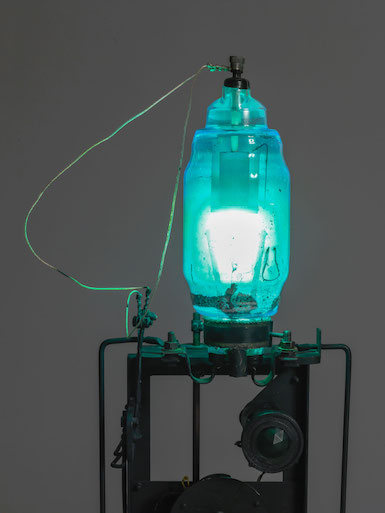[ad_1]

Takis, Télélumière No. 4 (detail), 1963–64.
©2019 ADAGP, PARIS, AND DACS, LONDON/PHOTO: ©TATE/ANDREW DUNKLEY AND MARK HEATHCOTE/TATE
On view now at Tate Modern in London is a retrospective for Takis, the Greek sculptor best known for his strange assemblages of magnets and lighting fixtures. With this show in mind, we’ve republished Lawrence Campbell’s review of Takis’s 1963 exhibition at Alexandre Iolas Gallery in New York, which is considered one of the most significant shows that the artist had in his lifetime. In that show, he debuted new sculptures making use of magnets. (Six years later, the artist would remove one of his sculptures from a show at the Museum of Modern Art, an act of protest that echoes in artists’ decision today to ask for their works to be pulled from the Whitney Biennial.) The review follows below. —Alex Greenberger
“Reviews and previews”
By Lawrence Campbell
December 1963
Takis [at Alexandre Iolas Gallery in New York], Greek-born sculptor, in Paris since 1955, has received considerable attention for his magnetic and kinetic sculptures. He calls these works Telesculptures, Telemagnets and Telephota. The last consist of three separate units wired together: a condenser with an antenna, next a mercury vapor tube in which a light boils like an imprisoned Tinker Bell and which looks like a robot above a Science-Fiction arrangement of wires, coils and other electrical equipment, finally an electro-magnet which cuts on and off and influences the oscillations of cork spheres or other hanging objects enclosing metallic substances, suspended from the ceiling. The telemagnets consist of a painted canvas concealing (except for a telltale bulge) a magnet. Various objects—metal horns, spheres and cut-out sign-shapes suspended by wires from the ceiling—are held in rigid immobility in the field of the hidden magnet, yet float free from the surface of the canvas itself. There are also several metal oblate spheroids with grooved markings like isobars. The sculptor’s intention is not to create a kind of Dadaist art, nor yet a Tinguely machine, but to demonstrate the esthetic possibilities of an actual magnetic force.
[ad_2]
Source link

